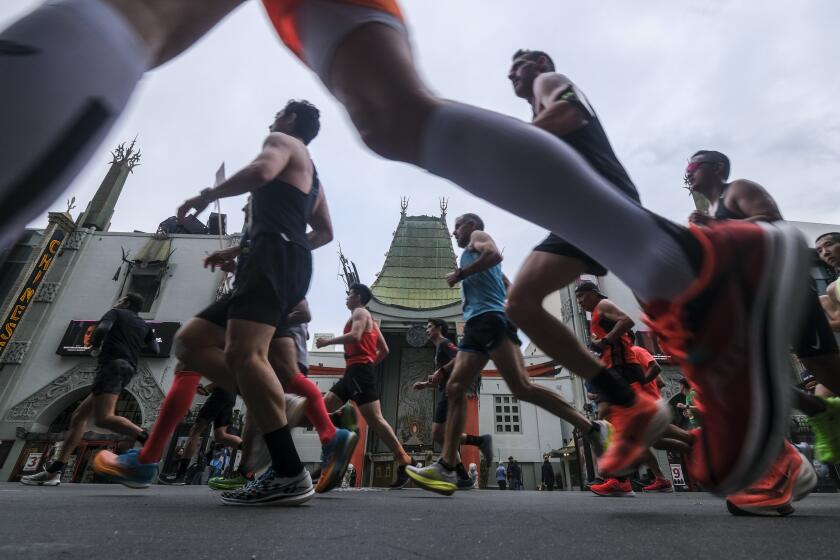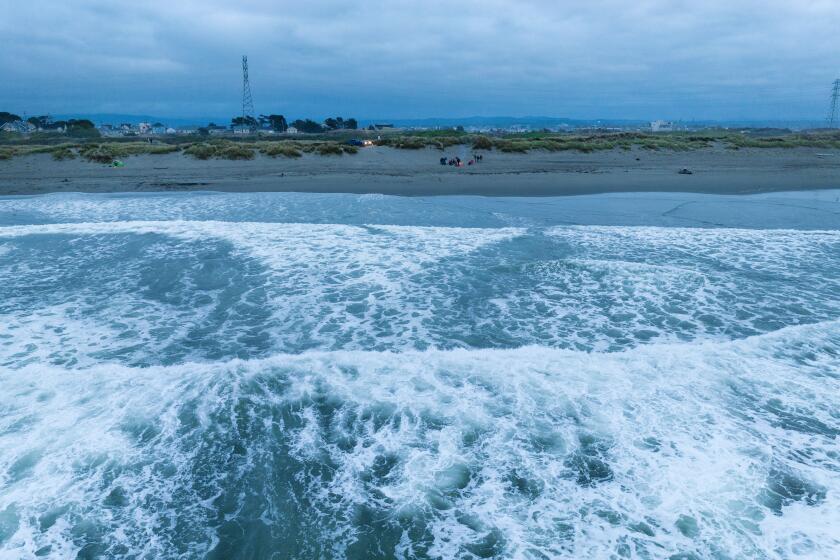Changes Cut Violence at Deadliest Prison in U.S.
- Share via
Three years ago, Richard Caruso, a big, gung-ho prison guard with the scars to prove it, turned on his fellow officers and blew the whistle on alleged brutality at Corcoran State Prison.
He slipped out of work one day with an armful of documents that detailed how Corcoran had become the deadliest prison in America, a place where seven inmates had been shot and killed by guards since it opened in 1989.
Handing over the documents to the FBI, he set off a lengthy probe into allegations of civil rights abuses at the San Joaquin Valley prison. The investigation, entering its fourth year, has yet to result in any criminal indictments.
A federal grand jury met again in Fresno last month to hear more testimony about the role prison supervisors and staff played in the last fatal shooting, the 1994 death of inmate Preston Tate. The Los Angeles gang member was killed by a guard while fighting another inmate in a recreation yard. The gunner was aiming for the other inmate and hit Tate by mistake, according to a prison report. A decision on indictments is expected within the next few months.
State corrections officials insist that no widespread brutality took place at the prison. They paint Caruso and other Corcoran whistle-blowers as malcontents fond of exaggeration. They say their own recent investigation found only isolated incidents of excessive force involving about a dozen officers. None of the incidents were related to the Tate case or other fatal shootings.
“We had an 18-member investigation team look into the charges, and they found nothing to support the allegations of the whistle-blowers,” said Tip Kindel, a spokesman for the state Department of Corrections.
This much is clear: In the past year since Caruso and other officers went public with allegations of unwarranted shootings, not a single inmate has been seriously injured or killed by guards trying to break up fights on the recreation yards.
“Even if the federal indictments never come down, we accomplished our goal,” said Caruso, who no longer works at the prison. “We stopped the shootings.”
Whatever the grand jury decides, the whistle-blowers and the families of the dead inmates probably will get their day in court. A civil lawsuit filed by the Tate family is headed to trial and has produced volumes of deposition testimony from prison officials, along with dramatic videos of several shootings.
Family members and their attorneys contend that the videos, filmed by prison cameras, raise serious questions about the internal investigations that ruled each shooting was justified.
The allegations center on practices at Corcoran’s maximum-security unit known as the SHU, a kind of prison within a prison for 1,800 gang members and other inmates with disciplinary problems. It is one of two such units in the state, the other at Pelican Bay State Prison. The tiers are arranged so that one guard can look into every cell from a single vantage. An officer with two weapons--a rifle and an anti-riot gun that fires nonfatal wood blocks--hovers above each of the SHU’s tiny concrete yards.
From 1989 to 1996, as a way to break SHU inmates of gang ties, the prison sent rival groups into the same cramped space to exercise. This so-called integration policy, handed down from top corrections officials in Sacramento, was based on the premise that if SHU inmates could learn to get along on a small scale, they might be trusted to mingle in the larger prison setting.
Critics say the integration policy ran counter to the realities of prison life. They point out that Latino, black and white inmates hardly mix on Corcoran’s main yard, which is big enough so that each rival group negotiates its own piece of turf. The SHU yard, by contrast, is half a basketball court.
The outcome was undeniable. Fights broke out constantly, many between warring Mexican gangs. In 1989 alone, SHU guards fired the anti-riot gun 694 times in an attempt to stop inmates from brawling. In 50 of those cases, gunners also fired the rifle at combatants, resulting in three killings.
Over a five-year period, seven inmates involved in fistfights were shot dead by officers at Corcoran--more fatal shootings than at any other prison in the country during the same period.
None of the fighters carried weapons or posed “great bodily harm” to each other before they were shot, contended Caruso and other officers and supervisors cooperating with the FBI. Such danger must be present before an officer can respond with deadly force.
“The only great bodily harm inflicted a lot of times was with our guns,” said Tom Simpson, a supervisor at Corcoran.
Before the whistle-blowers went to the FBI, internal documents show, they attempted to modify the integration and shooting policies from within. They wrote memos to Warden George Smith and higher-ups in Sacramento stating that SHU gunners were confused about when to fire the anti-riot gun and when to fire the rifle. Documents show that Smith and top officials responded by denying their requests for retraining or changes to policy.
Among the more sensational charges leveled by Caruso and the others was that some officers were sending rival gang members into an empty yard to do battle and then betting on the outcome, a ritual that became known as “gladiator days.” They said the gunners then used the fights as a pretext to shoot the inmates. Corrections officials, however, said their investigation found no evidence that guards were setting up fights or shooting inmates without justification.
“[Our investigation] couldn’t find any staff who had staged a fight,” spokesman Kindel said. “It does not mean that fights didn’t happen because of inappropriate application of policy, but the fights did not happen deliberately.”
Kindel attributed the violence in the SHU to staff misunderstanding of the integration policy. He said Corcoran was forcing rival gang members to mix in the same yard when it should have given them the option of exercising in a yard free from enemies.
In 1996, the staff was retrained on shooting and integration policies. For the past year, the prison has allowed SHU inmates to choose which yard they prefer. Kindel said there remains a big incentive for gang members to choose the integrated yard. Showing that they can get along with their enemies is the only way gang members can move from the SHU to the main prison.
“Since we increased training on the integration and weapons policy, the incidents have gone way down,” Kindel said. “They are getting the right mix on the yards and the prison seems to be operating at a much safer level.”
About one fight a day has broken out in the SHU yards over the past year, a sharp downturn. In nearly half of the 326 incidents, gunners fired the wood blocks to stop fights. Not once was a rifle used, Kindel said, and no inmates have been killed.
Caruso and the other whistle-blowers see these numbers as vindication. Corrections officials disagree.
“The whistle-blowers believe they did something positive, but I don’t think that’s necessarily borne out,” Kindel said. “It came at a high price. To bring that kind of cloud on the entire staff at Corcoran was really unwarranted. The problems were with a small number of staff involved in little isolated incidents.”
Kindel said the department has fired or demoted 13 officers and administrators involved in incidents of excessive force.
Lawyers for the families of inmates killed at Corcoran say corrections officials are downplaying the problem. Staff confusion was hardly the cause of such violence, they allege. The fights in the SHU yard became as much a fixture at Corcoran as the cotton fields that surround the penitentiary.
“It’s so absurd for them to be saying that all this violence was the result of staff confusion,” said Catherine Campbell, an attorney representing the Tate family. “The integrated yard policy was the prison’s main gang-busting technique. It was pursued wholeheartedly despite its deadly consequences.”
Campbell said the videos made by cameras set atop the SHU recreation yards contradict the official versions. Several show inmates squaring off to box and then one fighter lying motionless in a pool of blood, the fatal blow struck not by his rival but by a prison gunner overlooking the yard.
She contends that the videos raise serious questions about the internal investigations of each shooting. In each instance, a shooting review board found that the officer’s use of deadly force was justified.
“In every case, the shooting review board exaggerated or distorted a key aspect of the fight to justify the deadly shot,” Campbell said. “We know this from the videos, from analyzing them frame-by-frame. The films tell a different story than the findings of the review boards.”
It is the 1994 killing of Tate, a 25-year-old gang member imprisoned for rape, that remains the focus of the federal probe. In a videotape, Tate and his cellmate are seen waiting for the charge of two Latino gang members in the tiny SHU yard. The tape shows the fight, rifle shots being fired into the brawlers, then Tate being hit in the head.
The gunner was aiming for one of the Latino aggressors and hit Tate by mistake, according to a prison report. Campbell said Tate and the Latino gang members--sworn enemies--never should have been in the same yard.
The grand jury has issued a subpoena for the “entire personnel file” of former warden Smith, plus rosters of guards and prisoners at the security housing unit, the subpoena says.
The grand jury is trying to determine whether prison staff created a hostile environment that led to the killing and initially tried to cover up the death, according to a federal source.
The next step is uncertain.
“There’s no way I can comment on the likelihood of indictments,” said Carl Faller, the chief assistant U.S. attorney overseeing the case. “The grand jury proceedings are confidential, and they have to stay that way.”
More to Read
Sign up for Essential California
The most important California stories and recommendations in your inbox every morning.
You may occasionally receive promotional content from the Los Angeles Times.










